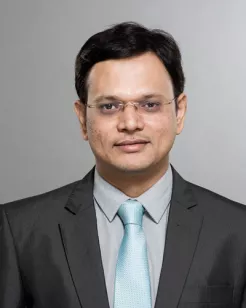Minimally Invasive Lumbar Fusion
Spinal fusion surgery is designed to stop the motion at a painful vertebral segment, which in turn should decrease pain generated from the joint.
Lumbar fusion is a surgical procedure performed to stop abnormal movement resulting from rubbing of individual vertebrae over another. In this procedure two or more vertebrae are fused using an implant (interbody cage filled with bone chips), screw and rod to eliminate painful motion, restore normal disc height and alignment providing stability to the spine thus preventing damage to spinal cord and nerves.
These procedures are referred to as transforaminal lumbar interbody fusion (TLIF ) and oblique lumbar interbody fusion(OLIF). These surgeries are performed in back or side of the back which incision less than 2.5 cms knows as minimally invasive lumbar fusion (MIS TLIF/OLIF
What is a spinal fusion?
Motion segment in the spine refers to an intervertebral disc with adjoining vertebra and facets joints. Back pain and leg pain occurs when abnormal motion occurs between two vertebrae leading to compression of nerves and spinal cord which occurs due to degenerative cascade as a part of ageing. The ideal treatment would require spinal fusion that is the placement of the interbody cage between two vertebrae and fixing them screw and rods. This procedure can be performed from the back or the side.
Conditions requiring spinal fusion
Degenerative disc disease
Failed back surgery
Spondylolisthesis
Spinal stenosis
Infection of spine
What are the symptoms?
Back pain - The most common symptom, typically worse with prolonged standing, bending and lifting and often relieves on lying down or sitting.
Pain in the back while getting up from sitting position.
Pain, numbness and weakness in legs (Sciatica) – as the spine becomes unstable and put pressure on nerves (stenosis).
Neurogenic claudication - buttock and leg pain and cramps caused by walking for a short distance, but the pain subsides on rest.
Loss of bowel and bladder function in cases of severe nerve compression.
Fever, in case of infection of the spine.
How is it diagnosed?
The preliminary investigation would be MRI and standing neutral and dynamic x-rays is advisable, because the spine bears its load in standing position which helps to assess the degree of deformity.
In case of infection will require contrast-enhanced MRI.
What are the treatment options?
Lifestyle modification – Restriction and modification of activities requiring sudden repetitive bending.
Physiotherapy – is a milder form of the disease
Medication - Analgesic and muscle relaxants, helps in acute episodes in easing pain.
No role of traction.
Lumbar corset / Belt – intermittent short term relief – Not advisable in the long term.
Surgery is indicated when the persistence of back pain despite rest and medication, leg pain at rest, progressive worsening spondylolisthesis, dynamic instability on x rays, infection showing the destruction of disc space. The goal of surgery being relieve symptoms, prevent worsening of symptoms and fuse the painful motion segment, can be performed from back (TLIF ) or OLIF ( side )
MIS TLIF is performed under general anaesthesia in a prone position. In conventional open surgery large incisions are made directly over the spine and then muscles are cut. With MIS techniques, using x-ray to localise the diseased vertebral levels multiple small incisions are made on side of back to access the disc space and pedicle ( for insertion of screws ).
Combination of dilators and tubular retractors, disc space is accessed to remove degenerated disc after removing a portion of lamina and facet joints. Then implant filled with bone graft is placed in disc space for fusion and alignment of the spine while maintaining musculature architecture. The screws are also inserted in a minimally invasive fashion and interconnected with rods.
OLIF is a less invasive way to approach the spine from the front and side of the body (guiding in a trajectory midway between the middle of the stomach and the side of the spine). The surgeon uses the natural space between the psoas muscle and the peritoneum to access and reaches the spine via long tubular instruments. The psoas muscles are long and tendinous muscles connecting the lower back to the thighs and enabling flexion of thighs and peritoneum is the membrane that lines the abdominal cavity. After removing the diseased disc interbody device will be put between your vertebrae which is filled with bone graft. The interbody device lifts your vertebrae to increase to disc space height and relieves compression of nearby nerves. The procedure is performed under general anaesthesia in lateral position. Pedicle screws are inserted in percutaneous fashion either in the lateral or prone position using a tiny small incision.
Our Doctors
We have some of the best specialists from around the world, they bring years of experience and offer evidence-based treatment to ensure the best care for you.




